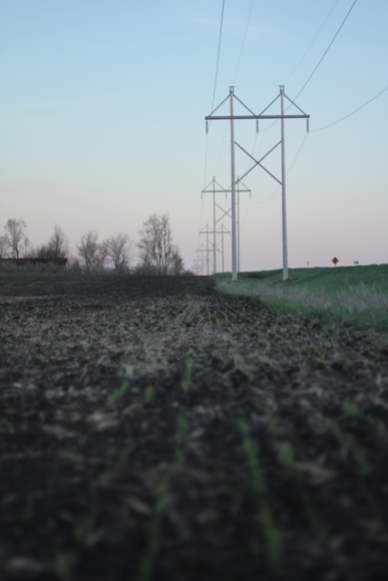
Click on the photo to enlarge it. Can you find the remnants of the old windmill?
Committed to Agriculture while Respecting the Earth
In a past blog, I’ve talked about how we are following in Grandpa’s footsteps by raising seed. As we look at the history of our farm, and the men who have built it to what it is today, we find little gems that make us squeal with delight.
I may or may not have jumped up and down like a little girl when we found a newspaper article featuring Grandpa Nuel, and Uncle Bob. The article talks about what it takes to raise seed, and why they do it. It also talks about why Bob built the shop that still stands at our place.
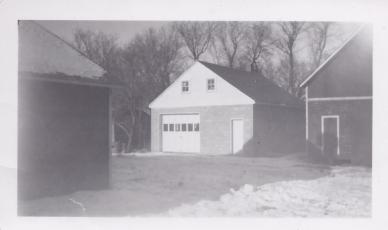
When I first read the newspaper article, the thing that struck me is how similar the seed production requirements are today as they were back in that time (we’re estimating the article was written around 1950). The author does a great job of explaining the whole process from planting, to harvest, to storage.
We live in a world where everything has to be the latest and greatest. If it is shiny, updated, loaded with features, we will do what we have to in order to get it. We “need” the software that organizes everything, the farm apps that keep cropping and livestock records, and iAnything to make our lives run efficiently. I will freely admit that I love my electronics!
Sometimes, though, we get little reminders that the “old” way isn’t as outdated as we thought. While our field inspectors may record things on their laptops, we still need the inspectors’ feet in the dirt, looking for things that could prevent us from selling our crop for seed. The process, as a whole, is solid. While we may have an easier time tracking lot numbers and field information with computers (and let’s be honest, hello printing capabilities! I can’t imagine hand writing out tags for 3000 bushels of seed!), the steps to go from seed to plant to grow to harvest to seed is still pretty good.
Like Grandpa is quoted as saying in the article below, we enjoy producing high quality seed. Some things never change.
(Click on the article to make it bigger)
We found one of Grandma Myrtle’s diaries from her time at S.A.U.M. We had no idea what those letters stood for, but we knew it was close to Luther Seminary in St Paul, MN. Then, we found photo albums from her time there…mystery solved! Grandma Myrtle and Grandpa Nuel attended the School of Agriculture at the University of Minnesota in St Paul! Nuel was a freshman in 1916-1917, and Myrtle was a freshman in 1920.
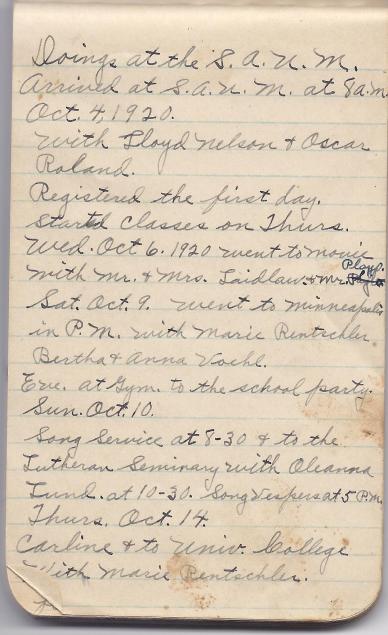
Grandma’s diary also mentions going to Luther Seminary to attend Vespers, going to volleyball and basketball practice at the YWCA, and which boys walked her home. The photos in her album include many of the “Cottonwood Bunch”, and the girls she would hang out with. I was pretty excited to find this photo of the campus from her time there:
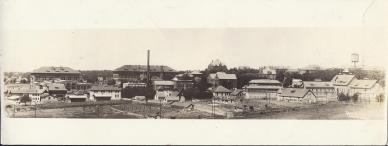
The joy we have found in reading Myrtle’s diaries, looking through her photo albums, and Nuel’s photo albums has made me a little more resolved to take more photos…and to label them! What we think is mundane, some day our descendents will find fascinating!
My absolute favorite line from Myrtle’s diaries was on the bottom of the page at the end of her first year at S.A.U.M:
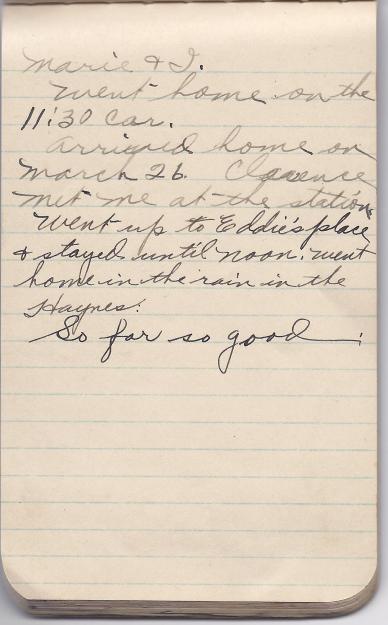
Tomorrow will be our youngest daughter’s 19th birthday. This summer, she is staying in her college town to work at her first “town job”. This will be her first birthday away from home. It may be cliche, but they grow up so fast!
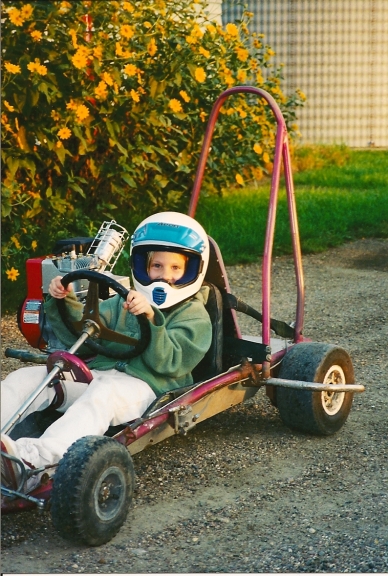
I think when Jonathan got his go-cart running, it took a few years off my life! Laura was either all on the gas, or all on the brake whipping around corners. She was little enough that she had to slouch down to reach the pedals. She’s had a couple other go-carts since this one, but the memory of the first day behind the wheel of this first cart really sticks out. I came to dread the phrase, “Hey, mom! Watch this!”
Happy Birthday, baby girl!
Our family is having fun researching the history of our farm as we prepare for our appreciation party planned for the end of June. For the next few Fridays, I’ll share a fun fact related to what we have found.
Today’s Fun Fact:
In 1914, for 50 cents, our farm was registered as Fairview Farm by Daniel Olson.
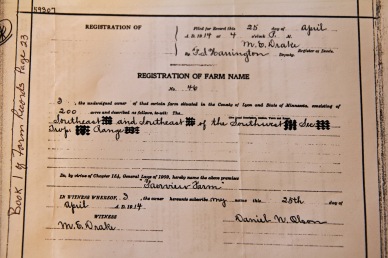
Memorial Day is a day set aside in the United States to remember those who gave their lives for our freedom. Many of us also remember all the family members and loved ones who have also gone on before us. Some will decorate graves with flags and flowers.
Sometimes, I wonder. Is one day enough to pay our respects to our military families, or the soldiers who gave the ultimate sacrifice? Shouldn’t we be thinking of them, praying for them, and showing our appreciation every day?
When I was growing up, we would visit my grandparent’s home in Iowa during the summer. In one corner, grandma had a little display area where she kept photos of my step-uncle, along with his medals and the flag that draped his coffin. He died when I was a toddler, so I never had the chance to meet him. Grandma would tell us stories of Johnnie, and we would always look at his bedroom upstairs, which was decorated exactly as it was when he left for Vietnam. Whenever Jonathan and I have been to Washington, DC, we always stop by the Vietnam Wall on a night tour. All 4 times we have taken this tour, it is either foggy and freezing cold, or raining. The weather makes this visit very emotional every time. But I wonder, is an occasional visit to a monument honoring these men and women enough?

Right now, my youngest brother is serving in the Army. He has been deployed for the past 10 months, leaving his wife and three sons state-side. I am loving the fact that they are in Minnesota, although with our winter, I’m not sure they are as thrilled! Although I haven’t been able to see them in person as much as I’d like, I have gotten to know them a little better. It is difficult for the extended families to really get to know the children of military families when they are living so far away. I feel blessed that we’ve been able to connect with our nephews this year.

While we have been able to connect with our nephews, my brother has missed out on many of their milestone events. They are fortunate that Bruce has been able to come home for short visits a couple of times, but that doesn’t make up for the things he’s missed.
What this year has taught me, is how important it is to support the military families as well as those who are deployed. My sister-in-law is a single parent to these three very active boys while her husband is away. I have always admired the way Heidi gets the boys involved in sports, and takes them off base to explore the area they are in. She has also gotten involved in spouse groups (mostly other women, but there’s been a few men as well), and has been active in running groups, and Bible studies. While in Minnesota, though, they have not had the advantage of living on a military base where everyone is pretty much in the same situation.
It seems as though people really can’t grasp the scope of the impact a deployment has on a family. There have been some incredibly insensitive comments from “friends” of hers on Facebook that are quite appalling. Once again, I have to admire Heidi, and the way she handles these people. This makes me wonder, is saying “Thank You” one day a year really enough?
Today, my Facebook and Twitter feeds are full of emotional photos and memes telling us how we need to remember the fallen, and thank those who are currently serving. It is good to spread that message, but how many of those who are posting these memes today will shake the hand of a soldier tomorrow? How many of us have sent an encouraging word to the military spouses who are being single parents while their husband or wife are deployed? How many of us have volunteered to watch their children so they can have a day to relax? How many of us have helped to mow lawns, or shovel driveways, or pick up an extra car-pool shift?
Remembering the fallen on Memorial Day is good. But sometimes, saying thank you to those who are currently serving just seems inadequate. Please, take the time to show your appreciation throughout the year.

Thanks to my friend, Emily Zweber of Zweber Family Farms, for the inspiration for this slightly sarcastic look at a farm wife working in the field.
On April 29th, we started seeding fields of wheat as well as fields of barley and peas. We raise a few varieties of wheat based on the needs of Albert Lea Seed House, who we raise seed for. This means we need to clean out the grain drill and the seed tender between varieties. We like to use a ShopVac® to get as much seed out as possible from the inside. We save the unused seed in case we need to replant a wet spot, or we’ll use it as part of a cover crop mix.
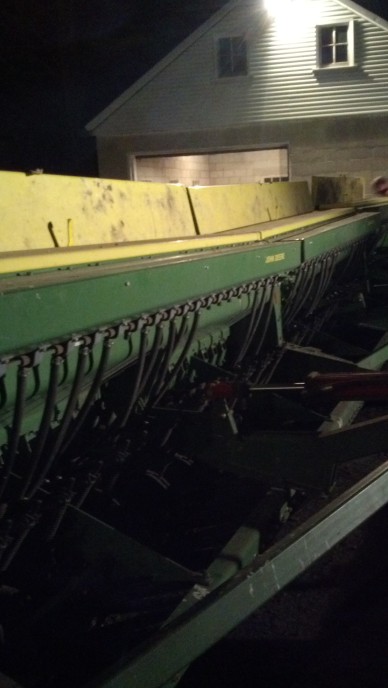
After the insides are vacuumed, we need to drop the trap door at the top of every seed tube. There are 60 seed tubes on our drill. I know that, because I count them every time I drop them.
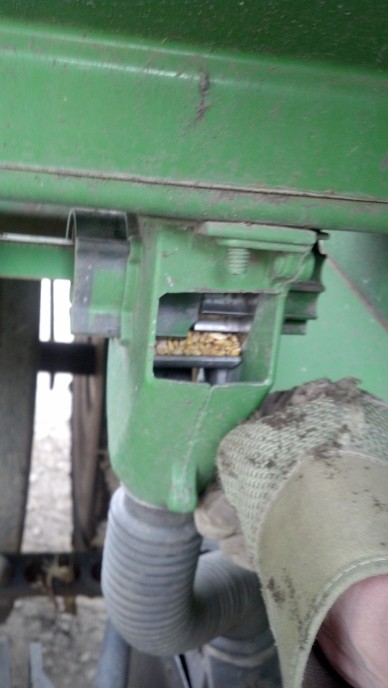
After the seed is emptied, I make sure each meter trap door is adjusted correctly for the type of seed we are using. Wheat seed is set with the narrowest opening, field peas have the medium opening. If I don’t get the openings set correctly, we’ll either lose a lot of seed, or won’t get the seed planted at the rate we want. In this photo, you can sort of see the little lever I’m grabbing to drop the seed. That same lever is the one that sets the width of the opening.
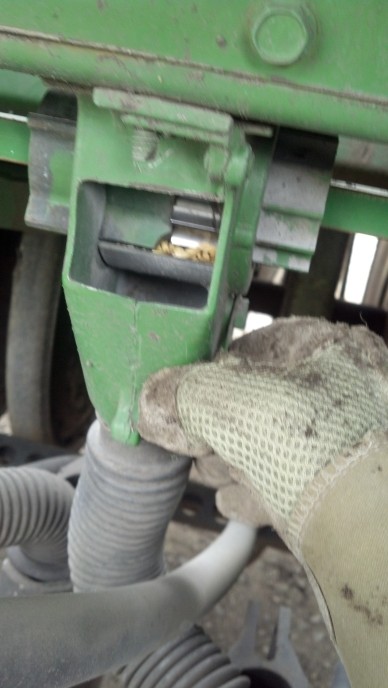
Once the tubes have been emptied, and the levers are on the correct notch, we are ready to refill. The drill is brought out to the field, switched from transport mode to field mode, then we are ready to load it up with seed.
More farmers are now using a mini-bulk system. Each mini-bulk bag holds the equivalent of 40 bags of seed, which saves on labor and paper bag costs…and for me, this year, chiropractor costs. The bags are hoisted up by the forklift, and dumped into a seed tender wagon. The seed tender has an auger system that is powered by the tractor’s hydraulic system.

After the seed tender has the right amount of seed in it, we pull it to the field with the tractor. Not a job I’m particularly fond of, but sometimes you just have to put on your big girl panties and do it. I hate transporting equipment on the tar roads, mostly due to the impatience of other drivers. If everyone slows down, and gives farm equipment plenty of room, all will be happier.
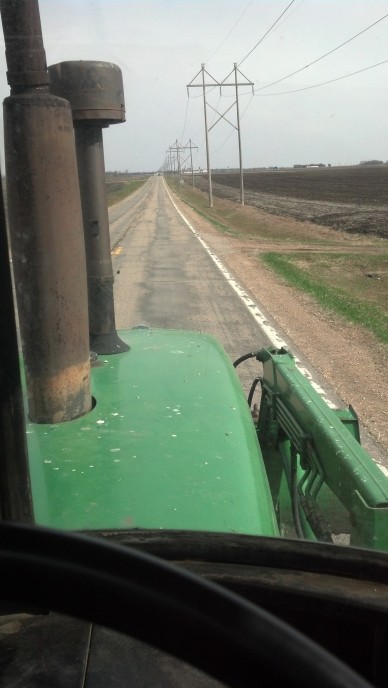
There are times when we still use small bags, depending on how much of that particular variety we are going to plant. For those situations, we drive the pickup – which has been loaded with the seed – out to the field. The end gate is about the same height as the walking platform on the back of the drill, so carrying bags from pickup to drill isn’t too difficult.
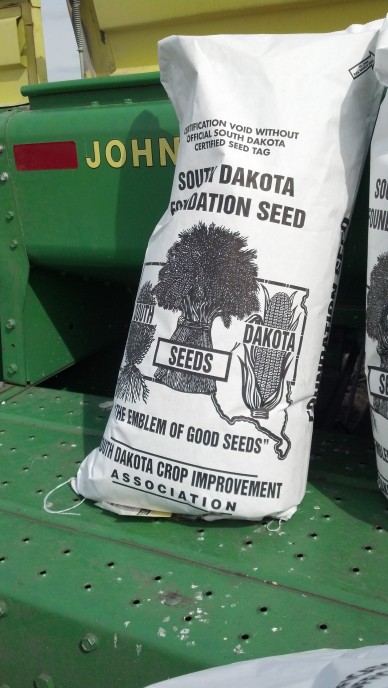
After we get the drill full of seed, Jonathan can start seeding.This brings up a question that I asked when I was still a new farm wife. Why is it called seeding wheat? When we use the grain drill, we use the term ‘seeding’. When we use the corn planter, we use the term ‘planting’. Soybeans can either be seeded with the grain drill (we call it solid seeding the soybeans), or planted with the corn planter. We plant our soybeans with the corn planter, because that is what works best for us. Just like everything else, different farms have different things that work for them.
Some of the photos above were taken at night, and some in the morning. If we were close to finishing a field, Jonathan would push it a little so we could get done with that field. There were a few nights of little sleep, but we got it all in before we received a nice rain. As of Mother’s Day, we can see the first wheat fields starting to show a green haze. One of my favorite things in spring is seeing the seeds pop, and the fields slowly turn green. (The photo below is barley, but the wheat field looks very similar…the barley was across the road from the house, so it was the easiest to photograph.)
